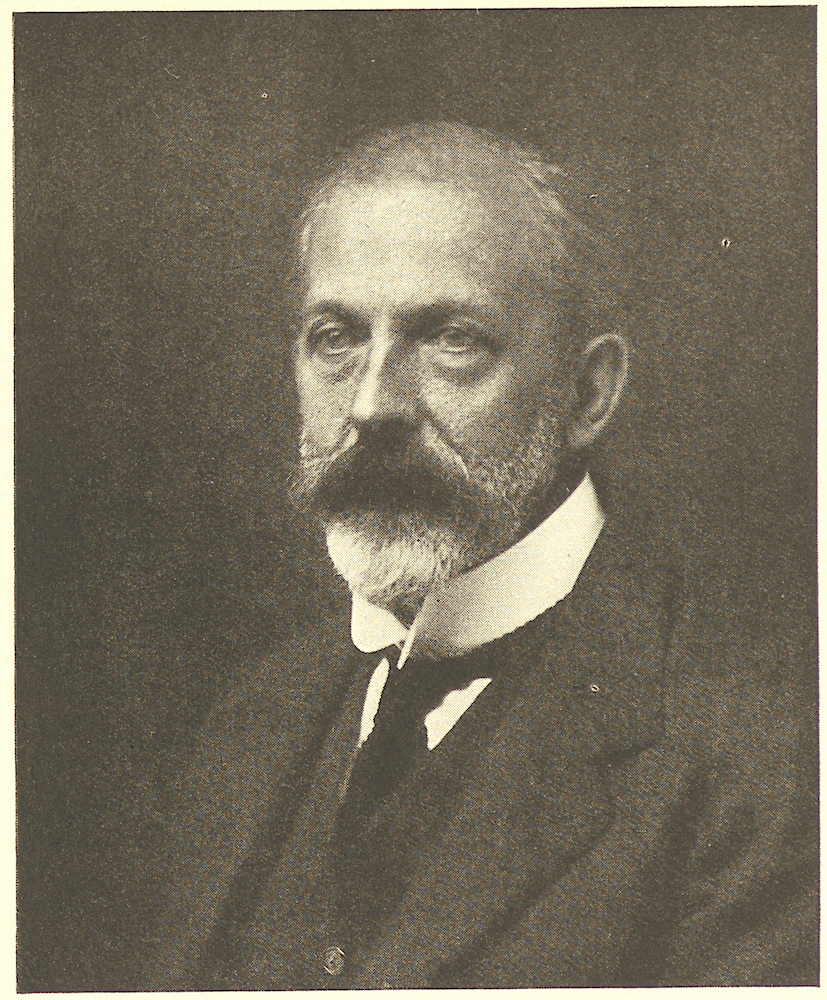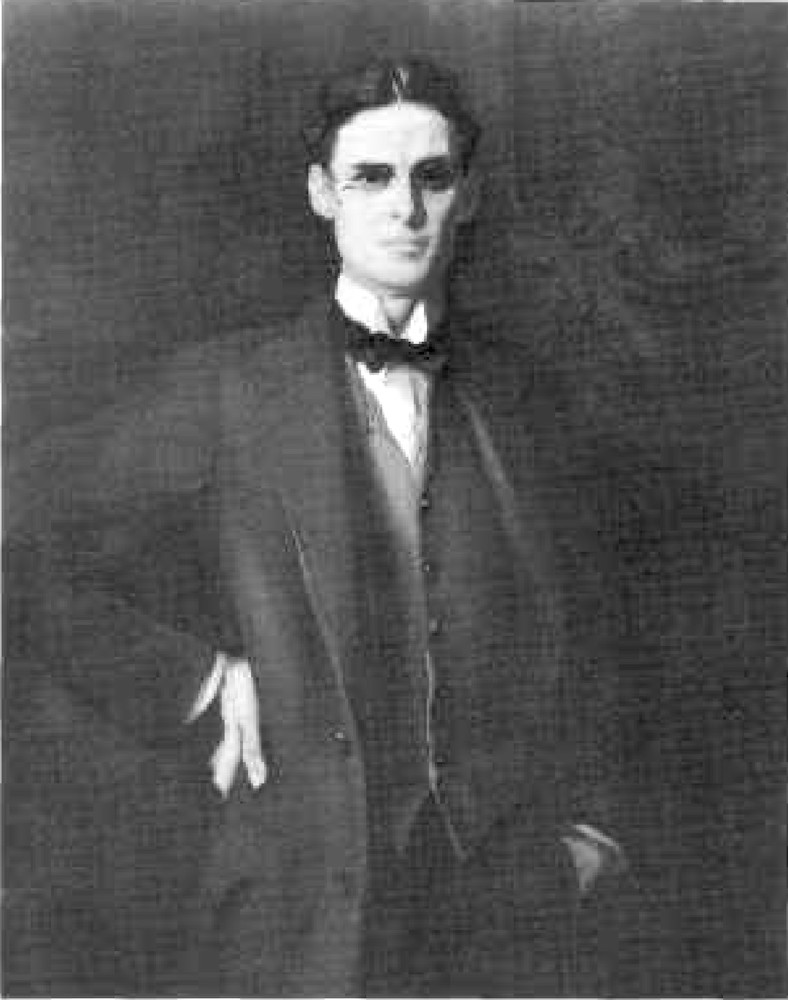
H. V. Lanchester F.R.I.B.A. Source: Reilly 112.
The partners in the late-Victorian/early twentieth-century architectural practice of Lanchester, Stewart and Rickards were Henry Vaughan Lanchester (1863-1953); James S. Stewart (1866-1904); and Edwin Alfred Rickards (1872-1920).
London-born Lanchester was the son of the architect Henry Jones Lanchester (1834-1914). He trained with his father before entering the office of Frederick James Eedle and partners, then set up on his own account. His first notable work from these early years was the extensive remodelling of "Bovril Castle," or Kingswood House, in Sydenham, at the enormous cost (in those days) of £10,000 (see Darby 8). Although this was already in hand when Lanchester entered into formal partnership with Rickards, around 1897, there were additions after the initial remodelling and the younger architect put his own distinctive stamp on this listed mansion's Scottish baronial details.
Successful as the new partnership with Stewart and Rickards would be, Lanchester went on to become a still more prominent figure in the next few decades. He served as editor of The Builder in 1910-12, and as Vice-President of RIBA (records of this can be found in the RIBA journals of 1913 and 1915). He also branched off successfully into town planning, with schemes in India, where he opened an office in Lucknow, and then Africa. Despite losing out to Sir Edwin Lutyens on the prime commission of colonial planning — including the government offices on Raisina Hill in New Delhi — Lanchester was still a pioneer in this field, and published a book entitled The Art of Town Planning in 1925. He was awarded the RIBA Gold Medal in 1934.


Right: From a portrait of Rickards (1911), by Frank Waldo Murray. Source: Brandon 47. Left: Cardiff City Hall (author's photograph).
Lanchester's partners were equally talented, although, sadly, neither of the original two lived long enough to collect such honours. Rickards has been described as "a lively, London-bred artist, a brilliant ornamentalist, cleverest of draughtsmen, and incessant talker" (Allinson 285), and a flavour of all that can be seen in Arnold Bennet's memoir of him in the little book of sketches, paintings, caricatures and so on collected at the end of his life. It is clear that, as an account of him in the Architectural Review suggests, he "got much of his sweetness and strength, and nearly all his inspiration" from his travels on the Continent ("Edwin Alfred Rickards," 100). It is clear, too, that his experiences in World War I ruined the health of someone exceptionally high-spirited, versatile and gifted: Bennett wrote bitterly about the War Office's decision to send "a distinguished artist over military age to act as a travelling clerk behind the lines in France" (6). Lanchester was equally upset, writing in the RIBA journal:
It is impossible not to deplore the loss of one for whom many years of activity might have been anticipated; the deprivation is the greater in that his genius had not reached its culminating point but was up to the last still progressing and gaining strength. Not only in regard to his own efforts, but in the stimulus he gave to others do we feel the poorer through his having left us. [472].
Deplorable too was the even earlier death of Stewart, a Scotsman who had won both gold and silver medals at the RA, and was admired as a critic (again, see Allinson 285, and the entry for Stewart in AHRnet). His obituary in The Builder points out that he had to retire from his work with the firm when still in his mid-thirties (see p.148), before dying at the age of 38.
Lancaster would take different partners later on: Geoffry Lucas (1872-1947) in 1920 and Thomas Arthur Lodge (1888–1967) in 1923. But that part of his story belongs to another era. — Jacqueline Banerjee
Biographical Material
Works
- Kingswood House
- Deptford Town Hall
- City Hall, Cardiff
- Methodist Central Hall, Westminster
- Third Church of Christ the Scientist, Mayfair
Bibliography
Allinson, Kenneth. Architects and Architecture of London. Oxford: Elsevier, 2006.
"The Annual Elections. Scrutineers Reports." Journal of the Royal Institute of British Architects. Vol 22 (12 June 1915): 401. Internet Archive. Web. 25 January 2024.
Bennett, Arnold. "Edwin Alfred Rickards: A Personal Sketch." The Art of E. A. Rickards, by Edwin Alfred Rickards. London: Technical Journals, 1920. 1-6. Internet Archive. Web. 25 January 2024.
Brandon, Laura. "The Canadian War Memorial that Never Was," Canadian Military History. Vol. 7, no. 4: 45-54. http://scholars.wlu.ca/cmh/vol7/iss4/5 (open access, at core.ac.uk).
Brittain-Catlin, Timothy. Edwin Rickards. Liverpool: Liverpool University Press / Historic England, 2023. [Review]
Brodie, Antonia. Dictionary of British Architects 1834-1914. Vol. 2, L-Z. London: Continuum, 2001. 9.
Curl, James Stevens. Oxford Dictionary of Architecture and Landscape Architecture. 2nd ed. Oxford: Oxford University Press, 2006.
Darby, Patrick. A History of Kingswood House, Dulwich. London: Southwark Local History Library, 2010. Open source. Internet Archive. Web. 25 January 2024.
Dixon, Roger, and Stefan Muthesius. Victorian Architecture. 2nd ed. London: Thames and Hudson, 1985.
"Edwin Alfred Rickards." The Architectural Review Vol.48 (October 1910): 100-01. Internet Archive. Web. 25 January 2024.
Gerstein, Alexandra. "Lanchester, Henry Vaughan (1863–1953), architect and town planner." Oxford Dictionary of National Biography. Online ed. Web. 25 January 2024.
"Kingswood House." Historic England. Web. 25 January 2024.
Lanchester, Henry Vaughan. The Art of Town Planning. London: Chapman and Hall, 1925. Internet Archive. Web. 25 January 2024.
Lanchester, H. V. "Edward Alfred Rickards." Journal of the Royal Institute of British Architects. Vol. 27 (25 September 1920): 470-72. Internet Archive. Web. 25 January 2024.
"Minutes. XV." Journal of the Royal Institute of British Architects. Vol 20 (14 June 1913): 575. Internet Archive. Web. 25 January 2024.
"Obituary: Mr. J. S. Stewart." The Builder. Vol. 87. 13 August 1904: 184. Internet Archive. Web. 25 January 2024.
Reilly, C. H. Representative British architects of the Present Day. London: Batsford, 1931.
"Stewart, James S. 1866 - 1904." AHRnet (Biographical Dictionary of British and Irish Architects 1800-1950: From Gothic Revival to the New Brutalism). Web. 25 January 2024.
Created 25 January 2024